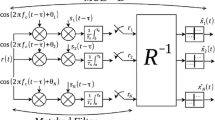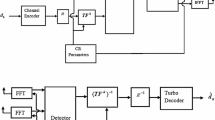Abstract
Each transmission from a base station in a mobile cellular direct-sequence CDMA network is a source of interference for the receivers in the mobile handsets that are operating in adjacent cells. This interference can limit the capacity of the forward traffic channels. The effect of adjacent-cell interference on the performance of the handset receivers is evaluated for a mobile cellular CDMA network that employs quadriphase-shift-key spreading, convolutional coding, and soft-decision decoding. It is demonstrated that acceptable performance may not be possible for a fully loaded cellular network. Of particular interest in this paper are cellular networks in which the base stations are mobile and must be interconnected by wireless communication links. Such networks are important for military applications and certain civilian emergency communications services.
Similar content being viewed by others
REFERENCES
TIA EIA Standard: Mobile Station-Base Station Compatibility Standard for Wideband Spread Spectrum Cellular System, TIA EIA-95–B, Telecommunications Industry Association, Washington, DC, March 1999.
A. J. Viterbi, CDMA: Principles of Spread Spectrum Communication, Addison-Wesley, Reading, MA, 1995.
D. P. Whipple, The CDMA standard, Applied Microwave & Wireless, Vol. 6, No. 2, pp. 24–37, Spring 1994.
R. E. Fisher, A. Fukasawa, T. Sato, Y. Takizawa, T. Kaot, and M. Kawabe, Wideband CDMA system for personal communications services, Proceedings of the 1996 IEEE Vehicular Technology Conference, Vol. 3, pp. 1652–1655, April 1996.
E. G. Tiedemann, Jr., An overview of the CDMA PCS system, Proceedings of the 1995 IEEE Long Island Section Wireless Communication System Symposium, pp. 189–194, November 1995.
D. L. Schilling, L. B. Milstein, R. L. Pickholtz, F. Bruno, E. Kanterakis, M. Kullback, V. Erceg, W. Biederman, D. Fishman, and D. Salerno, Broadband CDMA for personal communications systems, IEEE Communications Magazine, Vol. 29, pp. 86–93, November 1991.
D. N. Knisely, Q. Li, and N. S. Ramesh, cdma2000: A third-generation radio transmission technology, Bell Labs Technical Journal, Vol. 3, No. 3, pp. 63–78, July-September 1998.
M. B. Pursley, Spread-spectrum multiple-access communications. In G. Longo (ed.) Multi-User Communication Systems, Springer-Verlag, Vienna, pp. 139–199, 1981.
Author information
Authors and Affiliations
Rights and permissions
About this article
Cite this article
Macdonald, T.G., Noneaker, D.L., Pursley, M.B. et al. Adjacent-Cell Interference in Direct-Sequence CDMA Forward Traffic Channels. International Journal of Wireless Information Networks 7, 187–196 (2000). https://doi.org/10.1023/A:1009597722422
Issue Date:
DOI: https://doi.org/10.1023/A:1009597722422




